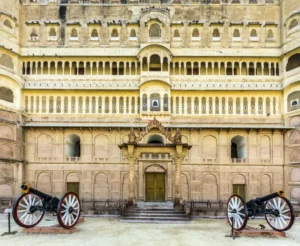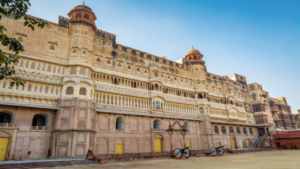Standing tall amidst the vastness of the Thar Desert, Junagarh Fort in Bikaner, Rajasthan, is a majestic testament to India’s rich heritage. Unlike other forts in Rajasthan that crown hilltops, Junagarh Fort, also known as Junagarh Fort Bikaner, stands proudly on flat plains, making it a unique landmark. This article delves into the fascinating history of Junagarh Fort, its architectural marvels, and its enduring legacy as a symbol of Bikaner’s grandeur.
History of Junagarh Fort
Junagarh Fort Bikaner’s story begins even before its current structure. In 1478, Rao Bika, founder of Bikaner, constructed an earlier stone fort, laying the foundation for today’s grand structure. However, the fort we know as Junagarh Fort Bikaner was built between 1589 and 1594 under the reign of Raja Rai Singh (1571-1611 AD). His Prime Minister, Karan Chand, oversaw the construction, and the fort was originally named Chintamani. It was later renamed Junagarh, which translates to “Old Fort” in the early 20th century when the royal family moved to their new residence, Lalgarh Palace.
Throughout its history, Junagarh Fort Bikaner played a crucial role in safeguarding the city. Its formidable 986-meter-long walls, punctuated by 37 bastions, provided a strong defense. The fort was even surrounded by a moat (now dry) for added protection. Despite facing attacks, Junagarh Fort Bikaner remained unconquered, except for a single instance where Kamran Mirza, son of the Mughal emperor Babur, briefly captured it but couldn’t hold onto it for long. This resilience adds to the fort’s historical significance.
Architecture of Junagarh Fort
Constructed from red sandstone and adorned with intricate marblework, Junagarh Fort Bikaner is a visual treat. The architectural style reflects a fascinating blend of influences – Rajput, Mughal, and even some European elements – reflecting the artistic diversity of the region and the changing times during its construction. The fort complex is a treasure trove of architectural wonders, each with its own story to tell.

Exploring the Grand Junagarh Fort Bikaner
Seven grand gates (pols) provide entry into the fort, each with its own architectural style and historical significance. The Suraj Pol, facing east, is a particularly notable entrance, with its imposing structure welcoming visitors. Within the fort walls lies a captivating world of palaces, temples, courtyards, and other structures.
Palaces
Several magnificent palaces grace the fort complex, each showcasing the opulent lifestyle of Bikaner’s rulers. Karan Mahal, a stunning example of Rajput architecture, is renowned for its intricate mirror work and gold leaf embellishments. Anup Mahal, famed for its beautiful painted ceilings and colorful tilework, offers a glimpse into the artistic sensibilities of the era. Ganga Mahal, with its unique blend of Rajput and Mughal styles, reflects the changing artistic tastes of the rulers. Badal Mahal, adorned with exquisite white marble latticework, provides a cool respite from the desert heat. Chandra Mahal, the oldest surviving palace within the fort, offers a glimpse into the early days of Bikaner’s royalty.
Museum
Established in 1961, the Junagarh Fort Museum houses a captivating collection of artifacts that tell the story of Bikaner’s royal past. From ancient manuscripts and weapons that showcase the region’s military prowess to royal costumes and exquisite jewelry that hint at the luxurious lives of the royalty, the museum offers a window into the lives of the kings and queens who resided here.
Temples
The Ratan Behari Temple, a place of worship for the royal family, is a significant site within the fort. This beautifully decorated temple, dedicated to Vishnu, holds special significance during festivals like Gangaur and Dussehra, when it comes alive with vibrant celebrations.
Other Structures
Courtyards with intricate latticework screens (jharokhas) used by royal women to observe the outside world, along with other architectural elements like ornately carved doorways and balconies, add to the fort’s charm. Within the fort complex, you might also find yourself walking past a haveli (merchant’s house) or a well, each piece adding to the narrative of life within the fort walls.
Planning Your Visit to Junagarh Fort Bikaner
Junagarh Fort Bikaner is a major tourist attraction, drawing visitors from all corners of the globe. It offers a glimpse into Rajasthan’s rich cultural heritage and showcases the architectural prowess of the region. The best time to visit Junagarh Fort Bikaner is during the pleasant winter months, from October to March when the scorching desert heat subsides. The fort is open daily from 9:30 am to 4:30 pm, allowing ample time to explore its vast complex.
For a truly enriching experience, consider hiring a local guide who can share fascinating stories and historical insights about the fort. Audio guides are also available in various languages for a self-guided tour.
Best Places To Stay Near Junagarh Fort
Bikaner offers a wide range of accommodation options to suit every budget. Several hotels are located near Junagarh Fort Bikaner, making it convenient for visitors to explore the fort and other attractions in the city. Choose from luxurious heritage hotels housed within old havelis, comfortable guesthouses, or budget-friendly hotels, all offering a comfortable stay within easy reach of the fort.
Here are some resources to help you find the perfect place to stay:
- Travel booking websites allow you to filter hotels based on price, amenities, and distance from Junagarh Fort Bikaner.
- Reviews on travel websites and forums can provide valuable insights from other travelers.
- Remember, your best hotel depends on your needs and preferences. Consider factors like budget, desired amenities, and the type of experience you seek.
When choosing a hotel near Junagarh Fort Bikaner, you will find a variety of options to suit your preferences and budget. Located just 2 miles from Junagarh Fort Bikaner is the Chandra Mahal Hotel. This 3-star property offers a taste of regal living within a modern setting. While not located within the fort itself, it boasts a name that echoes the grandeur of Bikaner’s royal past.
Chandra Mahal Hotel features:
- Air-conditioned rooms with comfortable amenities
- A beautiful garden for relaxation
- Friendly and helpful staff
- Convenient location for exploring the city
Before booking your stay at Chandra Mahal Hotel, it is always a good idea to check online reviews and compare prices with other hotels in the area.
Junagarh Fort Bikaner: A Timeless Legacy
A visit to Junagarh Fort Bikaner is a journey through time. Standing tall amidst the golden sands of the Thar Desert, the fort is a living testament to the region’s rich history, architectural brilliance, and the enduring legacy of its rulers. Whether you’re a history buff or simply someone who appreciates architectural marvels, Junagarh Fort Bikaner is sure to leave you with a lasting impression.
So, pack your bags, book your hotel near Junagarh Fort Bikaner, and embark on a captivating exploration of this magnificent desert jewel!


